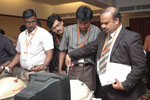Oesophagus
The oesophagus is a muscular tube, about 25cm long, with a sphincter (valve) at each end. Its function is to transport food and fluid, after being swallowed, from the mouth to the stomach. No absorption of nutrients takes place in the oesophagus. A mouthful of food which has been chewed and swallowed is called a bolus. This is propelled from the pharynx (throat) into the oesophagus, and is swept towards the stomach in peristaltic waves. These muscular contractions are involuntary, and cannot normally be felt. When food is not passing through, the oesophagus is folded in, or collapsed.
The sphincters at either end of the oesophagus are normally closed, acting as valves. The upper one, below the pharynx, opens upon swallowing to allow entry into the oesophagus. The lower one, at the entrance to the stomach, also only opens to allow food and fluid to pass through. This one - the gastro-oesophageal or lower oesophageal sphincter - plays an important role in stopping reflux of acidic stomach contents back into the oesophagus. Although mucus is produced in the oesophagus, it is not as protective as mucus in the stomach, and so is more susceptible to damage by gastric juice.
Stomach
The stomach is a temporary storage organ for large quantities of food. It can easily hold 1.5 litres, with a maximum holding capacity of about 4 litres. Its three main compartments are called the fundus, the body and the antrum. The stomach is also an important site for mechanical and chemical breakdown of the food which enters it. Digestive juices are secreted from glands covering the entire stomach wall. When food is present, approximately every 20 seconds mixing waves combine the food with gastric juices to form chyme - a creamy, semi-fluid mass. This is gradually emptied into the small intestine through a narrowed region surrounded by a thick ring of muscle at the lower end of the stomach - the pyloric sphincter. Liquids empty from the stomach faster than solids, taking about 20 minutes. A mixed meal takes about 1.5 hours to be emptied.
The stomach is also a secretory organ. The cells and glands in its wall produce several important secretions. These include: digestive enzymes ; hormones ; hydrochloric acid ; and intrinsic factor (for vitamin B12 absorption). A sticky, alkaline mucous is also produced to protect the stomach from its own acidity.
Small intestine
The small intestine is the longest section of the digestive tract, with an average length of about 6 metres. Although only 2.5 cm in diameter - which is why it is called the small intestine - its surface area for absorption covers the size of a tennis court. This is due to the numerous folds on its surface, covered in tiny projections known as villi, which in turn are covered in even tinier projections known as microvilli.
Large quantities of nutrients and water can be absorbed in the small intestine. Daily, it is capable of absorbing: several kilograms of carbohydrate; up to 1 kg of fat; 500gms protein; and 20 litres of water.
The surface cells of the small intestine are highly specialised for digestion and absorption of nutrients. Almost all the body's nutrient absorption occurs in the small intestine, along its three sub-divisions: the duodenum Þ jejunum Þ ileum. Sites for absorption of specific nutrients (eg: iron, vitamin.B12) are located in these divisions, but most absorption occurs in the jejunum (middle section). The specialised cells contain digestive enzymes, carrier proteins and other secretions. Blood vessels transport nutrients away from the intestine to the liver in the first instance.
Other features include:
Intestinal Crypts - these secrete enzymes, hormones and mucus
Peyer's Patches - lymph nodes preventing bacteria from entering the bloodstream
Brunner's Glands - these produce an alkaline mucus which protects the intestinal wall from gastric acid
Liver and biliary system
The liver is the body's largest organ, weighing about 1.5 kgs, or 2.5% of body weight. Major functions involve the uptake of nutrients and other substances from the intestine, processing (metabolising), storing or distributing these to blood and bile. The liver is also important in removing unwanted or harmful chemicals (detoxification) including chemicals produced in the body, unwanted chemicals taken into the body (eg carcinogens), and medications. The liver is the 'powerhouse' of the body.
Functionally, the liver is divided into lobes and segments, each with its own blood supply. It is like a large vascular 'sponge' with an extensive network of blood vessels. Blood entering the liver contains nutrients and other products which are extracted and processed. As a consequence, blood leaving the liver contains less of these substances. Liver cells - hepatocytes - are the liver's main functional units. These produce bile, distribute nutrients from the blood, store fat-soluble vitamins, and play important roles in detoxification.
The liver and biliary system produce bile and transport it to the small intestine, where it breaks up fats and other components of diet, and aids the digestion and absorption of these nutrients. About a litre of bile is produced daily. This leaves the liver via several ducts leading into the common hepatic duct, which joins the common bile duct (draining the gallbladder) and enters the small intestine. Excess bile is stored in the gallbladder, a green muscular sac approximately 10cm long attached to the lower part of the liver. If the gallbladder has been removed, bile is stored in the bile ducts which expand in size to hold the extra fluid.
Pancreas
The pancreas is a relatively small organ, which weighs around 100 grams and is about 15cm in length. It is the digestive system's main enzyme producing organ, and can be likened to a factory. Most pancreatic cells produce millions of enzymes daily. The pancreas is subdivided into small lobes, with ducts entering into a main duct. Along with the bile duct, the pancreatic duct enters the small intestine to deliver fluid through a small hole in the wall of the second part of the duodenum known as the papilla. This fluid is known as pancreatic juice, of which approximately 1.5 litres is produced each day. It is a rich mixture, containing enzymes capable of digesting all food types - protein, fat and carbohydrate. These enzymes are activated in the small intestine as needed. Pancreatic juice is highly alkaline, to help neutralise the acidity of the food which has just left the stomach.
A variety of hormones are also produced in the pancreas. These are made by cell clusters - Islets of Langerhans - interspersed throughout the tissue. Two major hormones are insulin and glucagon, which regulate carbohydrate metabolism. Other hormones control the release of pancreatic juice.
Colon
The colon - also known as the large intestine - is the final organ of the digestive process. It is responsible for drying out indigestible food residues by absorbing fluid and producing solid waste (faeces) for elimination. Approximately 1.5 metres long, the colon has six distinct regions leading from the join with the small intestine (ileocaecal valve): caecum, ascending colon, transverse colon, descending colon, sigmoid colon and rectum.
As in the rest of the digestive tract, the colon wall is muscular, which is necessary to move waste along the colon. Propulsion along the colon is slower than the small intestine, movement taking days rather than hours. Movement is stimulated by food and exercise, but is diminished during sleep. Transit time in the colon is about 1cm per hour.
Billions of bacteria inhabit the colon, where they ferment dietary fibre and other unabsorbed substances. The colon acts as a storage organ, where mixing movements promote absorption of water, electrolytes and bacterial fermentation products. Mucus produced in the colon is important in easing the passage of waste products towards the rectum and anus.






